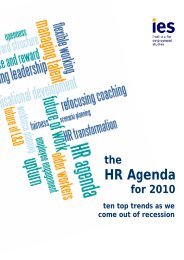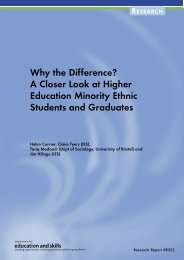Post-16 Transitions: a Longitudinal Study of Young People with ...
Post-16 Transitions: a Longitudinal Study of Young People with ...
Post-16 Transitions: a Longitudinal Study of Young People with ...
You also want an ePaper? Increase the reach of your titles
YUMPU automatically turns print PDFs into web optimized ePapers that Google loves.
pr<strong>of</strong>ound difficulties and those which presented particular<br />
challenges to the transition process.<br />
• In almost all <strong>of</strong> the case studies, there was at least one<br />
provider, agency or individual making great efforts to ensure<br />
that the young person progressed.<br />
• There was some evidence from the case studies that agencies<br />
worked well together (though not always) to address the wide<br />
range <strong>of</strong> young people’s needs regarding their academic<br />
progression, or social and personal needs. However, there was<br />
rarely one pr<strong>of</strong>essional, or champion, who had an overview <strong>of</strong><br />
the young person’s case (particularly post-<strong>16</strong>) and who was<br />
actively involved in shaping provision to meet their individual<br />
needs.<br />
• Examples <strong>of</strong> relatively smooth transitions seem to be the<br />
exception rather than the rule.<br />
• Planned transitions seem to work best where there is least at<br />
stake. For those young people <strong>with</strong> no real option other than<br />
to stay in education, the transition is effectively deferred for<br />
two to three years whilst the young person continues along a<br />
pre-ordained track.<br />
• Other young people experienced a range <strong>of</strong> disruptive factors<br />
when making the transition, not least a lack <strong>of</strong> real choice, or a<br />
lack <strong>of</strong> formal support and advice mechanisms/services to<br />
assist the decision-making process.<br />
• Parents and carers were found, not surprisingly, to be a<br />
particularly important resource in the transition process, and<br />
one which is not always fully harnessed and utilised.<br />
• In many <strong>of</strong> the case studies, there was evidence <strong>of</strong> progression<br />
for the young person in at least one domain ie in their current<br />
activity, acquisition <strong>of</strong> skills or qualifications, or their personal<br />
and social life.<br />
Conclusions<br />
From the survey and the case studies, two groups <strong>of</strong> young people<br />
stand out:<br />
• The first group relates to young people <strong>with</strong> largely<br />
uncontested impairments (eg sensory and/or physical<br />
disabilities) that have been identified at school. These young<br />
people generally have a statement, have attended a special<br />
school (or special provision in a mainstream school) and have<br />
had multi-agency intervention related to their impairment.<br />
Essentially, these young people constitute a fairly well-known<br />
population for whom there are clear transition pathways,<br />
although many are experiencing deferred transitions in post-<br />
<strong>16</strong> education. The issues for them are whether the pathways<br />
they are on are appropriate, whether they promote genuine<br />
progression and whether the high level <strong>of</strong> service co-<br />
xii

















